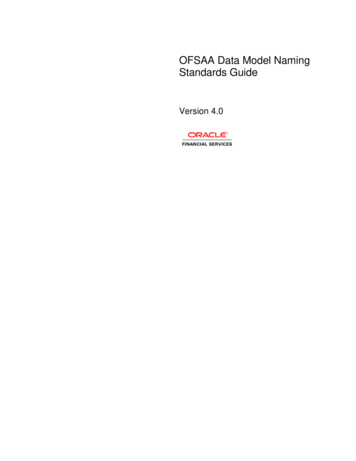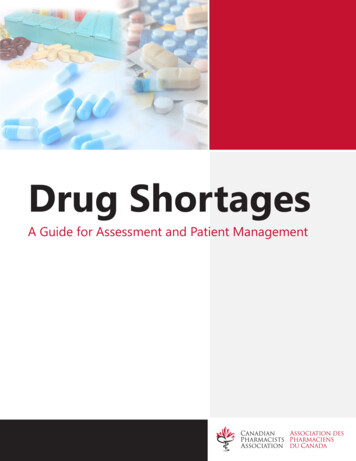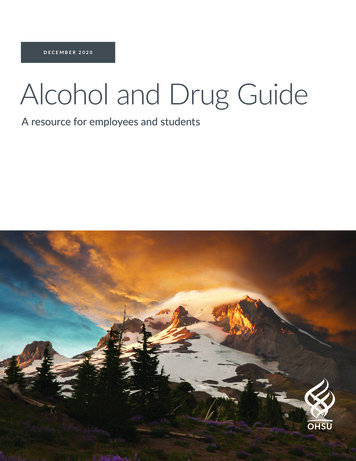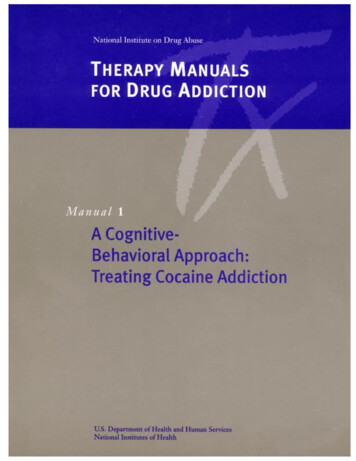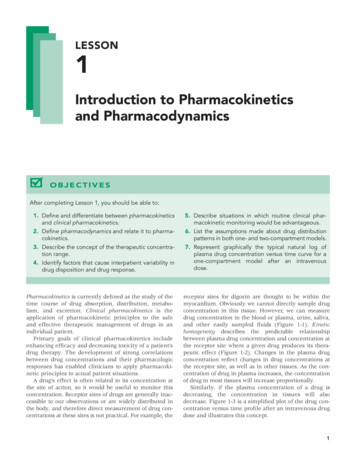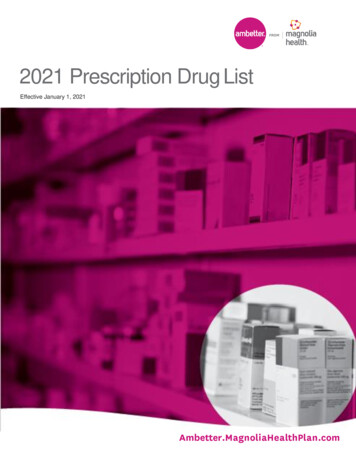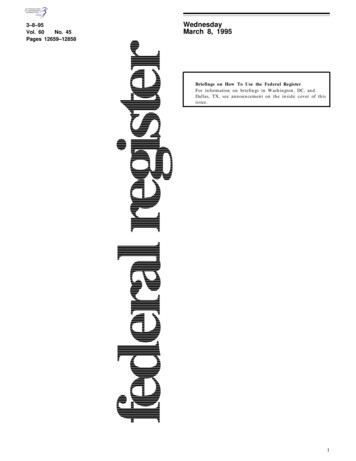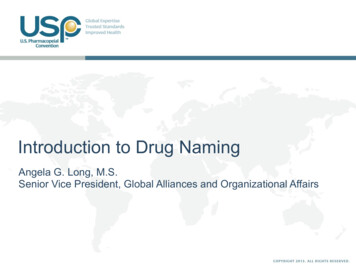
Transcription
Introduction to Drug NamingAngela G. Long, M.S.Senior Vice President, Global Alliances and Organizational Affairs
What’s in a Name?
International Nonproprietary Names (INN) Sponsored by World Health Organization. Facilitates the identification of pharmaceutical substancesor active pharmaceutical ingredients; nonbinding. INN is a unique name that is recognized to varying extentsglobally and is public property. The US does not follow INN; no role in federal law.3
US Adopted Names Council The US Adopted Names Council plays a role innonproprietary naming in the US. Sponsored by the American Medical Association, theAmerican Pharmacists Association, and USP, with activeparticipation by FDA. Works with INN but they are independent of each other. Drug substances only. Major role in naming drugs in development; 75% of USANnames don’t make it to market.4
USP-USAN Dictionary Entry5
USAN Entry for Insulin Human6
Biologics Naming: INN/USAN INN and USAN are working toward alignment;negotiations are aimed at achieving consensus. They both use similar approaches for naming biologics– Defining characteristics for biopolymers is the primary sequence– Biopolymers (proteins) with different glycosylation pattern aredifferentiated using a Greek suffix– Further elements of the name can include numbers (InterferonAlfa – 2a) At a recent INN meeting (April 15-18, 2013), aconsensus emerged to develop a naming convention forbiosimilars.At a public INN meeting (October 2013), INN suggesteda classification system for biosimilars, separate from theINN.
USP Naming/Nomenclature in the Law Ifthere are already applicable USP standards (determined byUSP monograph Identity) when FDA approves a drug or biologicfor marketing the “official title” in the USP monograph must beused as the official name for the drug substance and product (theFederal Food, Drug, and Cosmetic Act specifies that a drug with aname recognized in USP must comply with USP’s qualitystandards or be deemed adulterated or misbranded or both). When FDA approves a drug and there is no applicable USPstandard—which is likely in the case of new chemical entities—FDA provides an “interim established name” that serves as thenonproprietary name until USP creates a monograph.8
USP Naming/Nomenclature in the Law It’s important to note that USP’s broad role in naming appliesto both drug substances and products, and to all drugs,including biologics licensed by FDA under the Public HealthService Act. FDCA Adulteration and Misbranding provisions apply to PHSAct PHS Act 351(j)USP quality standard and naming role is effectuated for abiologic article when a USP monograph is published andbecomes officialAlthough FDA and USP work closely on nomenclature policy,USP naming is not directly implicated under either USPrules, or Federal law, until a compendial standard applies toa particular article
Role of USP Naming/Nomenclature In Law Drug deemed misbranded unless its label bears the“official title” recognized in USP-NF. FDCA 502(e)(3)FDCA & PHS Act drugs recognized in USP are deemedadulterated or misbranded if they fail to meet USPstandards for identity, strength, quality or purity (FDCA501(b); 21 CFR 299.5) packaging & labeling (FDCA 502(g)) FDA-approved names in NDAs and BLAs areconsidered by FDA to be “interim established names,”that exist only unless and until USP designates a name. See, e.g. Novartis v. Leavitt, 435 F.3d 344 (D.C.Cir. 2006)– FDA name may have to change: “The USP NomenclatureCommittee acts under its own schedule, so that its designation ofa name qualifying under §352(e)(3)(B) need not coincide with theFDA’s approval of a drug.”Novartis v. Leavitt, 435 F.3d 344, 352 (D.C. Cir. 2006).
Summarizing USP’s Role in Law A drug/biologic “shall” be deemed adulterated “if it purportsto be or is represented as a drug the name of which isrecognized in an official compendium, and its strengthdiffers from, or its quality or purity falls below, thestandards set forth in such compendium.” FDCA 201(j), 501(b) If USP has an applicable monograph (Identity), the drug/biologic is deemed misbranded unless its label bears the“official title” (naming) recognized in USP. FDCA 502(e)(3)– While it rarely happens that a USP Expert Committee would approvea monograph containing a nonproprietary name in the title that differsfrom that in the FDA license (e.g. a BLA ‘proper’ name), it is possible.– Congress did give FDA authority to specify a USP official title/name;but it cannot be done in an NDA or BLA – the only way to overrideUSP is by using notice and comment rulemaking. FDCA 508
USP’s Role in Naming USP’s role in naming applies to both drug substances anddrug products12
The Nonproprietary Name Provides the Link toUSP’s Publicly Available Quality Standards
USP’s Expert Committees Nomenclature, Safety, and Labeling Responsible for drug naming Members with expertise in drug naming andbackgrounds in pharmacy, nursing, medicine,biologics, and veterinary medicine from academia,industry, and various organizations FDA liaisons from CDER and CVMBiologics Monographs Expert Committees Establish USP’s monograph quality standards Members with expertise in biologics andbackgrounds in industry, academia, andorganizations; FDA liaisons from CBER and CDERWork closely to ensure the name and monograph testsare linked
USP Perspective on Biosimilar Naming No USP role regarding brand names; unique brand names OK Once biosimilars are approved, if the drug meets therequirements of the USP identification test of an existing USPmonograph, it should use the USP monograph title for itsproper/official/established name (unless FDA designates anofficial name under FDCA 508, using notice and commentrulemaking) USP encourages FDA to pursue the idea of an ‘orange book’for biologics15
Scientific Considerations for NamingRecommendations from USP’sBiologics Expert CommitteesTina S. Morris, Ph.D.Vice President, Biologics & Biotechnology
Boundary AssumptionUSP standards are a critical, but by no means allcomprehensive set of parameters that describe attributes andquality of an article in commerce, they can potentially be ahelpful resource of relevance to regulatory licensing decisionmaking, but are not intended for that purpose, hence:A USP monograph under the same title maydescribe multiple articles in commerce that differin specific aspects of their licensed attributesthat are not covered in the monographi.e., FDA may prescribe additional standards that are materialto an article’s “sameness”17
USP Name and Compendial Identity USPGeneral Notices 5.40.Identity A compendialtest titled Identity or Identification is provided as anaid in verifying the identity of articles as they are purported to be,e.g., those taken from labeled containers, and to establishwhether it is the article named in USP–NF. The Identity orIdentification test for a particular article may consist of one ormore procedures. When a compendial test for Identity orIdentification is undertaken, all requirements of all specifiedprocedures in the test must be met to satisfy the requirements ofthe test. Failure of an article to meet all the requirements of aprescribed Identity or Identification test (i.e., failure to meet therequirements of all of the specified procedures that arecomponents of that test) indicates that the article is mislabeledand/or adulterated.18
What Does this Mean in Practice?Several orthogonal Identity Tests:procedures should 1. Chromatographic Purity by HPLC probe different 2. Peptide Mappingidentifying attributesof the article,including the primary Bioidentity: Bioassaysequence.19
The Challenge of Glycosylation1.Unlike the primary sequence of a protein, glycosylation is not atemplate-driven process, rendering it more variable andsusceptible to changes that occur during molecule synthesis2.It may or may not have an influence on the structural,functional, and clinical characteristics of the molecule – it mayor may not be a critical quality attribute3.The analysis of complex glycosylation patterns and the level ofheterogeneity and microheterogeneity made visible is directlylinked to the resolving power of the applied analyticaltechnology20
Isoelectric Patterns of Epoetin a and b(a) Purified urine EPO, (b) epoetin beta, (c) epoetinalpha, (d,e,f,g,h) patients samplesRecombinant erythropoietin in urine, Nature 405, 635 (June 2000)Françoise Lasne, Jacques de Ceaurriz21
USP’s Experience to Date USPto date does not have an official monograph for a recombinanttherapeutic that addresses glycosylation, but is currentlyconsidering a monograph proposal. Typicaldeliberations by the USP Expert Committees include:1.1. Consider the existing USAN name(s) and compendialstandards in other pharmacopeias where they may exist2.2. Consider proposed test(s), their specificity and resolvingpower in the context of the article identity and scope of theentire monograph3.3. Reconcile proposal with previous and existing namingapproaches in the compendium for biological medicines22
USP monograph Identity) when FDA approves a drug or biologic for marketing the official title in the USP monograph must be used as the official name for the drug substance and product (the Federal Food, Drug, and Cosmetic Act specifies that a drug with a name recognized in USP must comply with USPs quality
